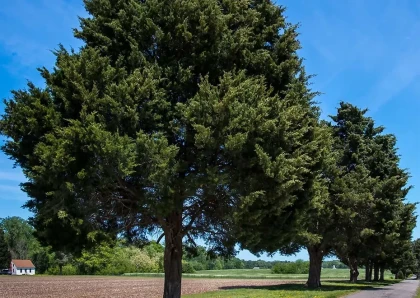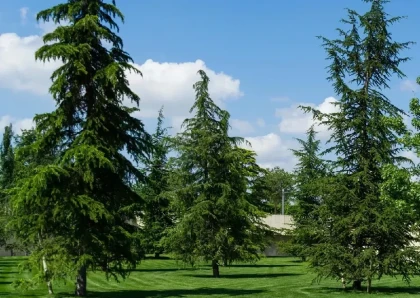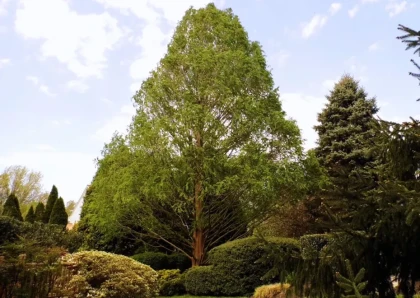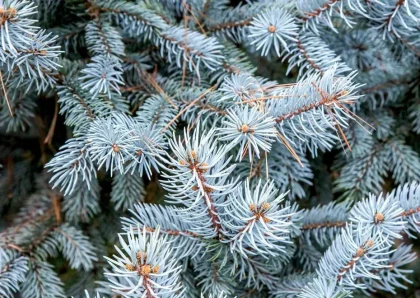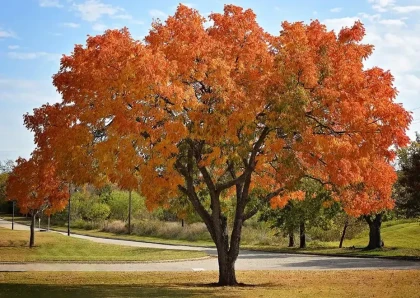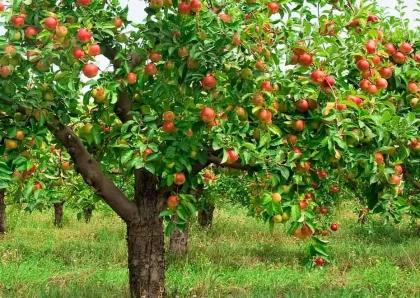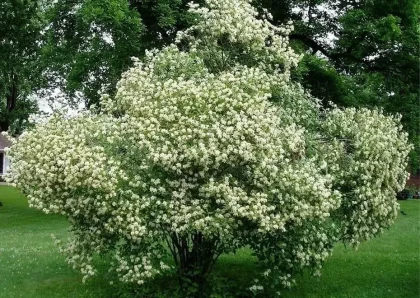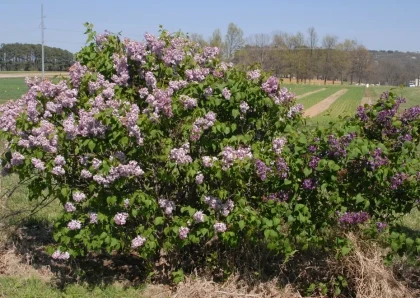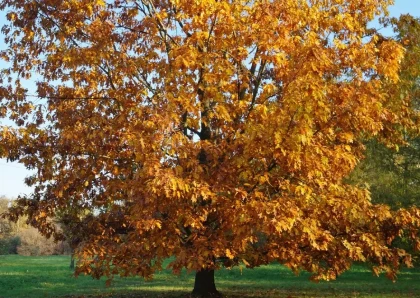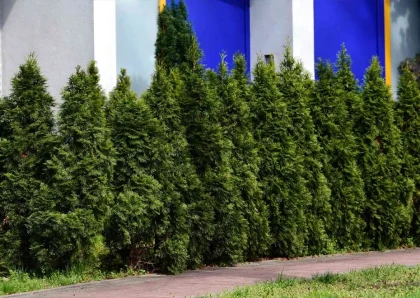
Douglas Fir Tree
Overview
The Douglas Fir (Pseudotsuga menziesii) is an evergreen coniferous tree that belongs to the Pinaceae family. It is one of the most common and commercially important trees in North America, particularly in the western regions of the United States and Canada. The name "Douglas Fir" can be a bit misleading, as it is not a true fir tree (Abies genus) but instead belongs to the genus Pseudotsuga.
Characteristics of the Douglas Fir tree
- Size: Douglas Firs are large trees that can reach heights of 200 to 300 feet (60 to 90 meters) or even taller in optimal conditions. They are among the tallest trees in the world.
- Needles: The needles of a Douglas Fir are flat and linear, measuring about 1 to 1.5 inches (2.5 to 4 cm) long. They are arranged spirally on the branches and give off a pleasant, citrus-like scent when crushed.
- Cones: The cones of the Douglas Fir are distinctive and can help in identification. They are cylindrical in shape, about 3 to 4 inches (7 to 10 cm) long, and have three-pointed bracts that protrude from each scale.
- Bark: Young Douglas Fir trees have smooth, grayish-brown bark that becomes thicker and develops deep fissures with age.
- Habitat: Douglas Firs prefer moist, temperate climates and are commonly found in mixed forests alongside other conifers like Western Hemlock, Western Red Cedar, and various spruce species.
- Uses: The Douglas Fir has significant economic value due to its strong and durable wood. It is widely used in construction, for making furniture, and in various other applications requiring sturdy timber.
Different Varieties of Douglas Fir
Coastal Douglas Fir (Pseudotsuga menziesii 'menziesii')
- Also known as the Pacific Douglas Fir or Oregon Pine.
- Found along the western coast of North America, from southern Alaska to northern California.
- This variety prefers the moist, mild climate of coastal regions.
Rocky Mountain Douglas Fir (Pseudotsuga menziesii 'glauca')
- Also known as the Interior Douglas Fir or Rocky Mountain Douglas Fir.
- Occurs in the mountainous regions of western North America, from British Columbia to Mexico.
- This variety can tolerate colder and drier conditions compared to the Coastal Douglas Fir.
Wood Products from Douglas Fir Tree
- Lumber and Timber: Douglas Fir is widely used for producing structural lumber and timber in construction. It is a popular choice for beams, joists, rafters, and other load-bearing elements due to its strength and dimensional stability.
- Plywood: Douglas Fir plywood is commonly used in construction and furniture making. It is made by gluing together thin layers of Douglas Fir veneers, creating a strong and stable sheet material.
- Flooring: Douglas Fir flooring is prized for its attractive appearance and durability. It can be used for both residential and commercial applications, providing a warm and natural look to spaces.
- Doors and Windows: Douglas Fir wood is suitable for crafting doors and window frames due to its resistance to warping and its ability to hold hardware securely.
- Furniture: Douglas Fir is a popular choice for crafting furniture due to its strength and beauty. It is commonly used for tables, chairs, cabinets, and other indoor furniture pieces.
- Millwork and Trim: Douglas Fir is often used for decorative millwork and trim in architectural applications, adding a touch of elegance to interiors.
- Beams and Poles: Douglas Fir beams and poles are used in various construction and landscaping projects, such as bridges, pergolas, and outdoor structures.
- Decking: Douglas Fir decking is a durable and attractive option for outdoor decks and patios, providing a natural look and withstanding the elements well.
- Paneling: Douglas Fir paneling is used for wall coverings and ceilings, creating a warm and inviting interior environment.
- Wood Pellets: The residues and by-products of Douglas Fir processing can be used to produce wood pellets, which are used for heating and energy generation.
Benefits of Douglas Fir Tree
- Strong and Durable: Douglas Fir wood is known for its strength and durability, making it an excellent choice for construction and structural applications.
- Attractive Appearance: The wood from Douglas Fir trees has a beautiful appearance, with a reddish-brown color and attractive grain patterns.
- Workability: Douglas Fir is easy to work with, allowing for smooth cutting, shaping, and finishing, which is beneficial for various woodworking projects.
- Resistant to Decay: The heartwood of Douglas Fir is naturally resistant to decay and insect attacks, increasing its longevity and reducing the need for chemical treatments.
- Versatility: Douglas Fir wood can be used for a wide range of applications, including lumber, plywood, flooring, furniture, doors, and more.
- Abundant Supply: Douglas Fir is one of the most common and commercially important trees in North America, ensuring a steady supply of wood for various industries.
- Carbon Sequestration: As a large and long-lived tree, Douglas Fir plays a role in carbon sequestration, helping to mitigate the impacts of climate change.
- Wildlife Habitat: Mature Douglas Fir forests provide habitat for various wildlife species, supporting biodiversity and ecological balance.
- Reforestation: Douglas Fir trees are suitable for reforestation efforts due to their adaptability and ability to regenerate naturally.
- Scenic Beauty: Douglas Fir forests contribute to the scenic beauty of landscapes, enhancing recreational and tourism opportunities.
Tips for Planting and Maintaining Douglas Fir Tree
Planting:
- Choose the Right Location: Douglas Fir trees prefer full sun or partial shade and well-draining soil. Select a planting site with sufficient sunlight and ample space for the tree to grow to its full size.
- Plant in Early Spring or Fall: Planting in early spring or fall when the soil is moist and temperatures are mild provides the tree with the best chance of establishing healthy roots before the extremes of summer or winter.
- Prepare the Planting Hole: Dig a hole that is slightly larger than the root ball of the sapling. Loosen the soil around the hole to encourage root penetration.
- Add Organic Matter: Mix some compost or well-rotted manure into the soil before planting to improve its fertility and water retention.
- Plant at the Right Depth: Place the sapling in the planting hole at the same depth as it was in the nursery container. Avoid planting it too deep or too shallow.
- Water Thoroughly: After planting, water the tree deeply to help settle the soil and promote root establishment.
Maintenance:
- Watering: Douglas Fir trees require regular watering, especially during dry periods. Water deeply but less frequently to encourage deep root growth.
- Mulching: Apply a layer of organic mulch, such as wood chips or bark, around the base of the tree. Mulch helps retain moisture, suppresses weeds, and regulates soil temperature.
- Pruning: Minimal pruning is necessary for young Douglas Fir trees. Remove any dead or damaged branches and avoid excessive pruning until the tree is well-established.
- Fertilization: Douglas Fir trees generally do not require regular fertilization. However, if growth is slow or the tree appears nutrient-deficient, a balanced fertilizer may be applied.
- Protect from Pests: Keep an eye out for pests and diseases that might affect the tree's health. Consult with a local arborist or extension office for proper diagnosis and treatment options.
- Stake Young Trees (if needed): If your sapling is susceptible to strong winds or unstable soil, consider staking it to provide support during its early years.
- Monitor for Water Stress: Pay attention to signs of water stress, such as wilting or yellowing foliage, and adjust watering accordingly.
- Prevent Compaction: Avoid excessive foot traffic or heavy machinery around the tree's root zone to prevent soil compaction, which can harm the tree's root system.
Cons of Planting Douglas Fir Tree
- Large Size: Douglas Fir trees can grow to be very large, reaching heights of up to 200 to 300 feet (60 to 90 meters) or even taller. This may be a disadvantage in limited planting spaces or if the tree obstructs views or power lines.
- Slow Growth: Douglas Fir trees have a relatively slow growth rate, especially in the early years. It may take many years for the tree to reach its full height and size, which may not be suitable for those seeking rapid results or quick shade.
- Competitive Root System: Douglas Fir trees have a competitive root system that seeks out water and nutrients. This can lead to competition with other nearby plants and trees, potentially affecting their growth and survival.
- Need for Adequate Space: Due to their size and competitive root system, Douglas Fir trees require ample space to grow without hindrance. Planting them too close to buildings, structures, or other trees may lead to issues later on.
- Susceptibility to Pests and Diseases: While generally healthy, Douglas Fir trees can be susceptible to certain pests and diseases. Without proper care and monitoring, pest infestations or diseases could affect the tree's health and growth.
- Environmental Impact: Planting non-native species like Douglas Fir in certain regions may have ecological implications, disrupting native ecosystems and affecting the balance of native flora and fauna.
- Fire Hazard: In some regions, dense stands of Douglas Fir can create a fire hazard due to the accumulation of flammable debris and the high resin content in the wood.
- Allergenic Pollen: Some individuals may be allergic to the pollen produced by Douglas Fir trees, leading to respiratory issues and discomfort during the pollen season.
- Cost and Maintenance: Planting and maintaining a Douglas Fir tree require investment in time, effort, and potentially money for watering, fertilizing, and pest control.
- Long-Term Commitment: Douglas Fir trees are long-lived and can live for hundreds of years. Planting one is a long-term commitment that may require care and attention for generations to come.
Conclusion
The Douglas Fir (Pseudotsuga menziesii) is a remarkable and widely appreciated tree with numerous benefits and a few considerations. Its strength, durability, and attractive appearance make it a popular choice for various wood products, including lumber, plywood, flooring, furniture, and more. Its adaptability to different climates and its role in carbon sequestration contribute to its ecological significance.
However, before planting a Douglas Fir tree, it's crucial to be aware of potential cons, such as its large size requiring ample space, slow growth rate in the early years, and competitive root system that can affect nearby vegetation. Monitoring and managing potential pest and disease issues are essential for maintaining its health and longevity.
When properly planted and cared for, the Douglas Fir tree can be a valuable addition to landscapes, providing both aesthetic beauty and ecological benefits. Understanding its characteristics and requirements will help ensure a successful and rewarding experience with this magnificent coniferous tree.
Frequently Asked Questions
1. What is the scientific name of the Douglas Fir tree?
The scientific name of the Douglas Fir tree is Pseudotsuga menziesii.
2. Is the Douglas Fir a true fir tree?
No, despite its name, the Douglas Fir tree is not a true fir tree (Abies genus). It belongs to the Pseudotsuga genus.
3. Where is the Douglas Fir tree commonly found?
The Douglas Fir tree is commonly found in North America, particularly in the western regions of the United States and Canada.
4. What are the uses of Douglas Fir wood?
Douglas Fir wood is highly valued for its strength and durability. It is widely used in construction, for making furniture, plywood, flooring, doors, and various other applications requiring sturdy timber.
5. How tall can a Douglas Fir tree grow?
Douglas Fir trees can reach heights of 200 to 300 feet (60 to 90 meters) or even taller in optimal conditions, making them one of the tallest trees in the world.
6. When is the best time to plant a Douglas Fir tree?
The best time to plant a Douglas Fir tree is in early spring or fall when the soil is moist and temperatures are mild, providing the tree with the best conditions for root establishment.
7. What care does a young Douglas Fir tree need?
Young Douglas Fir trees require regular watering, protection from pests and diseases, and minimal pruning. Adequate space and proper soil preparation are also essential for their healthy growth.
8. How long does a Douglas Fir tree live?
Douglas Fir trees are long-lived and can live for hundreds of years, given the right conditions and care.




